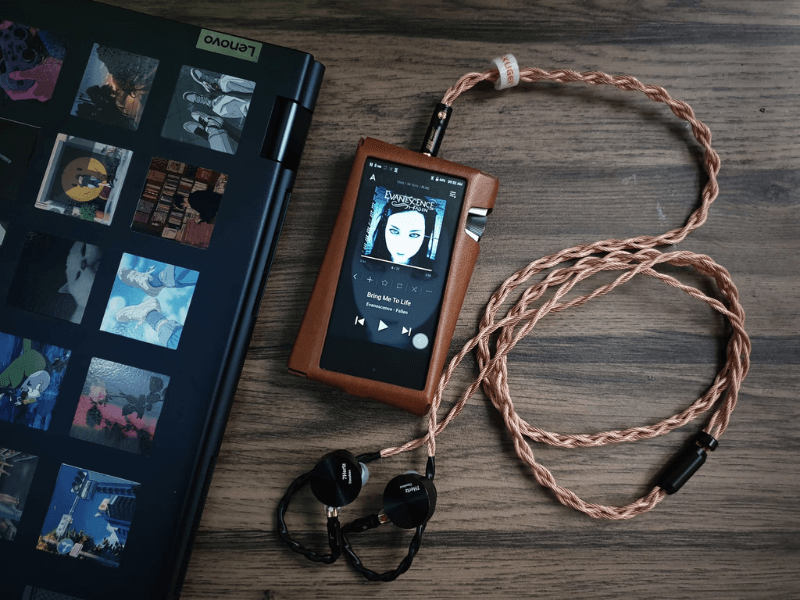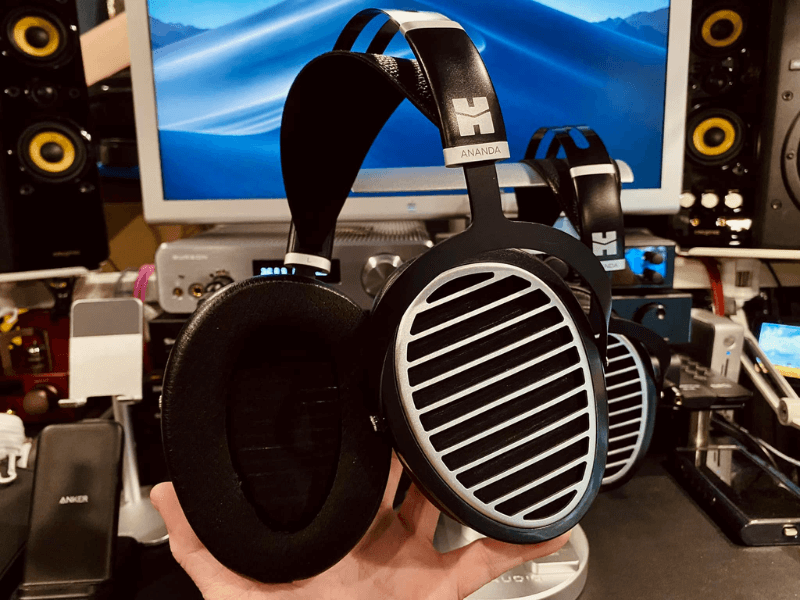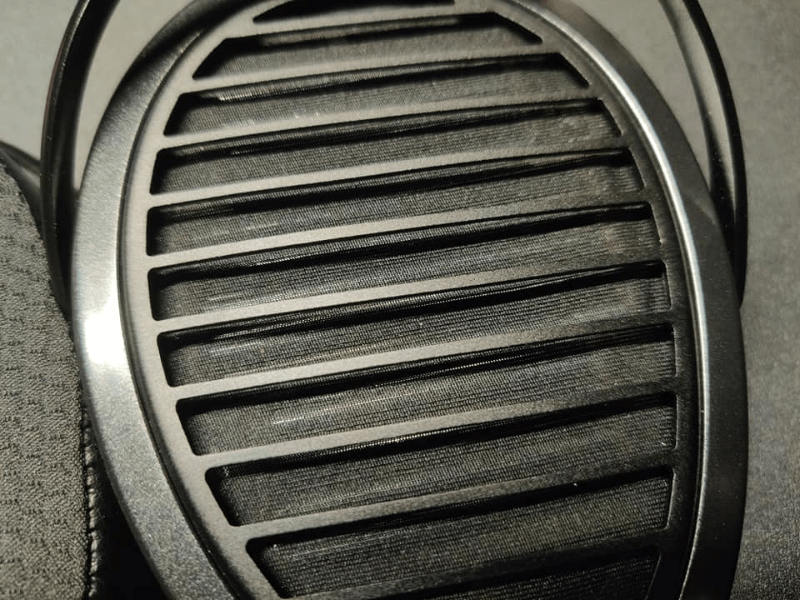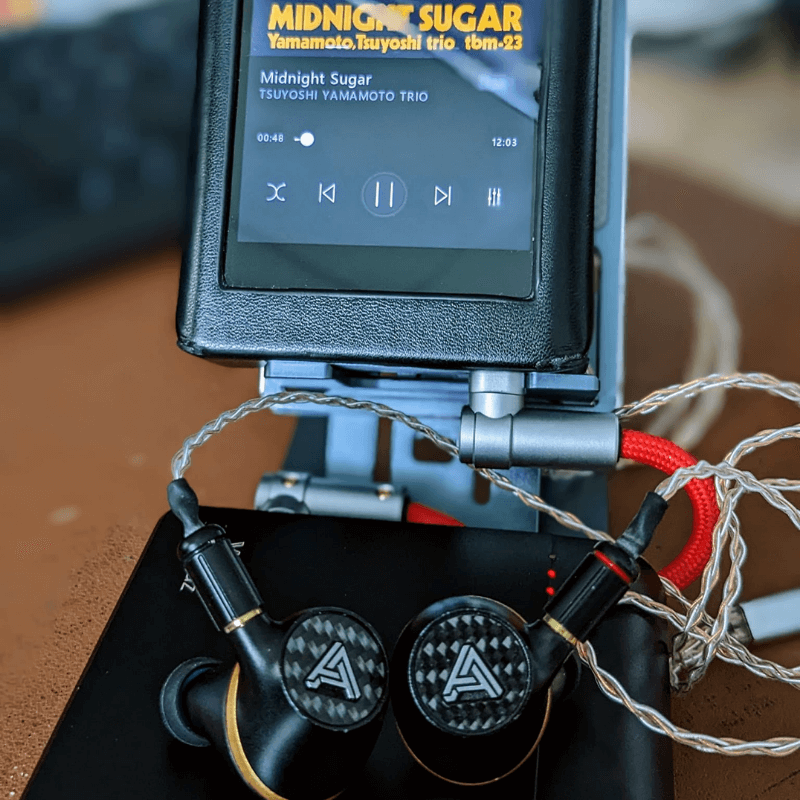Most headphones in the market use dynamic drivers to reproduce sound. However, planar magnetic drivers have proven to be slightly superior to dynamic drivers in terms of sound quality. However, planar headphones can be more expensive. No matter your budget, we’ve reviewed our best planar magnetic headphones in this article, and there’s something for everyone. To complete your system, check out our lists of the Best Headphone Amps and Best DACs.
Planar Magnetic Headphones Comparison Table
| HEADPHONES | IMPEDANCE | SENS** | FREQ** | DESIGN | WEIGHT |
|---|---|---|---|---|---|
| HIFIMAN Arya SM Version | 32 Ohm | 94 dB | 8-65,000 Hz | Open-back, Over-ear | 404g (14.3oz) |
| 7HZ Timeless | 14.8 Ohm | 104 dB | 5-40,000 Hz | Closed-back, In-ear | 11g (0.39oz) |
| Audeze LCD-5 | 14 Ohm | 90 dB | 5-50,000 Hz | Open-back, Over-ear | 420g (14.8oz) |
| HiFiMAN Ananda | 16 Ohm | 92 dB | 8-55,000 Hz | Open-back, Over-ear | 398g (14oz) |
| Audeze Euclid | 12 Ohm | 105 dB | 10-50,000 Hz | Closed-back, In-ear | 30g (1oz) |
| HiFiMAN HE400SE | 25 Ohm | 91 dB | 20-20,000 Hz | Open-back, Over-ear | 390g (13.75oz) |
| Tin HiFi P1 Plus | 22 Ohm | 108 dB | 10-20,000 Hz | Closed-back, In-ear | 11g (0.39oz) |
| HiFiMAN Sundara | 37 Ohm | 94 dB | 6-75,000 Hz | Open-back, Over-ear | 372g (13.12oz) |
| Audeze LCD-2 Classic | 70 Ohm | 101 dB | 10-50,000 Hz | Open-back, Over-ear | 544g (19.19oz) |
| Fostex T50RP MK3 | 50 Ohm | 92 dB | 15-35,000 Hz | Semi-open, Over-ear | 315g (11.11oz) |
*SENS – Sensitivity
**FREQ – Frequency Response
Best Overall Planar Magnetic Headphone
1. HIFIMAN Arya Stealth Magnet
- Impedance: 32 Ohm
- Sensitivity: 94 dB
- Design: Open-Back, Over-Ear
- What We Like: Masterclass imaging, Transparent & accurate, Super comfortable, Easy to drive, Wide and spacious soundstage, Lightweight
- What We Don't: Bass not visceral
HiFiMAN doesn’t need a long introduction. It’s a well-established audio company that has fully ventured into planar magnetic technology with its diverse headphones. The Arya is strategically positioned between the Ananda and other TOTL headphones from the company.
The Stealth magnet edition of the Arya is because of the round-shaped magnets that reproduce an even and distortion-free sound.
The build quality is really good, even though the earcups are made of plastic. That is a good compromise between the overall weight and build quality. The overall design and all-black color make it look elegant and stealthy, just like its name. For the build quality and design, Arya nailed it perfectly, and it’s hard to complain.
At 404g, the Arya is a light planar magnetic headphone considering others are much heavier. The earcups are large and have enough space to accommodate even larger ears. The pads, too, make the headphone comfortable due to their softness and excellent breathability. The headband does a great job of balancing the headphone with no pressure points and a good clamping force. The only downside is the earcups can be too big for some users with smaller heads.
The Arya is well-balanced and neutral sounding for the overall sound without exaggerating any part of the frequency response. Bass tuning is great and reference-quality with good transition to the mids. In the mids, voices and instruments sound organic with good transparency. The headphone is slightly bright but not sibilant. Detail retrieval is very good, and you” find the Arya resolving yet not analytical.
For the technicalities, the soundstage is wide open and spacious, reconstructing presentations with a good sense of ambiance. However, its masterclass imaging sets the area apart from the competition. Laser sharp positioning on the stage area makes sound come alive. Overall, this is one of the best headphones out there.
See the HiFiMAN Arya Stealth Magnet
Best Planar Magnetic IEM
2. 7Hz Timeless
- Impedance: 14.8 Ohm
- Sensitivity: 104 dB
- Connector: MMCX
- What We Like: Great fit, Soundstage is good, Decent build quality, Fun and engaging sound, Bass extension, Easy to drive
- What We Don't: Imaging could be better
The world of Chi-Fi has bought with it so many good IEMs, that cannot be matched, considering their price-to-performance ratio. The 7Hz is such an IEM and is a cheap planar magnetic IEM that sounds fun and engaging.
For the design, the shape of the Timeless is a break away from the norm. They are large, and circle shaped protrudes slightly outside the ear. The IEMs feel well-built with an all-metallic construction and a black finish. The overall weight is good despite the metallic material, but the size is bigger. The cable provided is of good quality and terminates at the earpiece in an MMCX connection.
Despite their larger size than most IEMs, the 7HZ Timeless is a comfortable IEM. The IEM protrudes slightly outside the ears, but they can’t go anywhere once you get a snug fit. Isolation is good, but you’ll still hear ambient noise when no music plays. Overall, the comfort and fit of this IEM is good.
If you want a fun and engaging planar IEM, the 7HZ Timeless is a good pick. The bass has power to it and comes out in good quantity and quality. The mids are slightly pushed back, just enough to create a nice sense of space. There is also a good degree of separation. The high-end is bright and airy signature with plenty of energy. The notes are crisp, and the extension is quite good.
The soundstage is reproduced effortlessly and has nice width, good depth, and an acceptable height. The imaging is good for the price, with absolutely no congestion anywhere. Everything plays out nicely on the stage and is easy to pinpoint.
Best High-End Planar Magnetic Headphone
3. Audeze LCD-5
- Design: Open-back, Over-ear
- Impedance: 14 Ohm
- Sensitivity: 90 dB
- What We Like: Warm balanced sound, High workmanship, Speed & resolution, Light & comfortable
- What We Don't: Mid heavy
The LCD-5 is a TOTL headphone from Audeze and one of the best high-end headphones. If you’re looking to spend your money on a flagship headphone, the Audeze LCD-5 is a top performer worthy of consideration.
The most obvious difference from its predecessor is the lower weight for the build quality. The LCD-5 is significantly lighter and also slightly smaller. The Audeze LCD-5 comes in a premium metallic, and the wooden rings have been replaced with acetate rings. The headband adjustment rods are still Audeze style but slightly improved. The headband is a two-piece design with a leather strap that sits on the head and a carbon fiber strap on top.
The comfort is much improved from its predecessor, but their new earcup design also increases the clamping force. The earcups are also slightly smaller compared to its predecessor. The clamp out of the box is high, but as the headband stretches over time, it becomes more comfortable. The headband is more comfortable and sits nicely on the head without any hotspots.
The overall sound of the LCD-5 leans toward a neutral tonality with an emphasis on the midrange. The bass has good extension, but it does not have much impact. The mids are boosted, and the vocals come out fairly well. Although the mids are forward, they don’t sound hollow. Instead, they are detailed. The highs are clear, airy, and fatigue-free, which is a treble We’ve not heard with other Audeze headphones. The soundstage is not super wide, but the imaging is top-notch.
Overall, for someone looking for a TOTL planar magnetic headphone, we recommend the LCD-5. The workmanship is great, and although it falls slightly in some aspects, it still has an amazingly balanced tuning.
Planar Magnetic Headphones Buying Advice
How Planar Magnetic Drivers Work
Planar magnetic drivers use two magnets with an equal magnetic force; thus, their other name is isodynamic. The two magnets are placed parallel, and a diaphragm is suspended between them. The diaphragm of a planar magnet is very thin and has thin conductors embedded into it.
When current is applied, the embedded conductors in the diaphragm are electrically charged, thus creating a magnetic field. The magnetic field reacts with the two permanent magnets on opposite sides, which causes the diaphragm to move, thus creating sound. Because the diaphragm moves over its entire surface, so it does not suffer distortion like dynamic drivers, even at higher volumes.
The first designs of planar magnetic headphones utilized two double-sided magnets, which made them quite heavy. However, over the years, the designs have been improved and refined. There are now single-sided planar magnetic arrays, which has made them even lighter.
Planar Magnetic vs. Dynamic Drivers
Dynamic drivers use a dome-shaped diaphragm attached to a voice coil at the center. The voice coil sits inside a magnet structure that also helps move it. When an electric charge is introduced, the coil creates electromagnetism that interacts with the magnet and moves the coil, thus moving the diaphragm.
Compared to planar magnetic drivers, the main difference is the diaphragm of planars is flat and has embedded conductors. However, these conductors and voice coil coil-on dynamic drivers are what help create the sound.

Using The Astell & Kern SR25 DAP and 7HZ Timeless
For the sonic differences, planar magnetic drivers have a cleaner and well-controlled bass. However, the bass lacks the visceral power that you would get from dynamic drivers. Dynamic drivers pack a punch and create a harder-hitting bass. If you’re a bass-head, dynamic headphones should be your go-to headphones.
Planar Magnetic vs. Electrostatic Drivers
Electrostatic drivers have a very thin diaphragm that is sandwiched between two perforated metal plates (strators). The diaphragm is coated by a conductive material that holds a constant electrical charge. When an electrical charge is introduced, it alternates back and forth between the stator.
These stators generate static electricity that helps move the diaphragm. Because static electricity is very weak, electrostatic drivers need so much power to be able to move the diaphragm.

Audeze LCD 5
The difference between electrostatic and planar magnetic headphones is their diaphragm and the power needed to drive the drivers. Because the diaphragm of electrostatic drivers is very light, their transient is very fast, and they perform exceptionally reproducing magical sounds. However, you’ll need special amps to power an electrostatic headphone, which is more expensive.
Over-Ear vs. In-Ear Headphones
Our list of the best planar magnetic headphones includes both over-ear and in-ear headphones. While there were few in-ear headphones around the last few years, the growth of Chi-Fi has brought with it many models that are more affordable.
Over-ear headphones, especially planar magnetic headphones, tend to be bigger and bulky. This is mostly to accommodate the larger drivers that form part of the driver. However, with developing technology, over-ear planar magnetic headphones have reduced both in size and overall weight. A case in point is the Audeze LCD-5, which now weighs 420g (14.8oz). Its predecessor, the Audeze LCD-4, weighs 690g (24.3oz), which is a considerable change in weight.

Big Earcups Of The HiFiMAN Ananda
To make planar magnetic headphones more comfortable, manufacturers make the overall design and fit better. Softer and more comfortable materials are used to help offset their weight and bulky designs. However, because most are for critical listening, their design makes does not affect them much.
If you want a portable planar headphones, In-ear headphones are the way to go. The likes of 7HZ Timeless and Audeze Euclid have been reduced to make planar magnetic technology enjoyable in the move. This offers you a planar magnetic sound while commuting or on the move. The sound difference is very minimal, and planar IEMs can still get you detailed sound while remaining portable.
Open-Back vs. Closed-Back Designs
The major headphone designs are open-back and closed-back. Open headphones mean their earcup enclosure is open to allow air and sound to enter and escape the earcup. With open-back headphones, you’ll notice vents or perforations on the back of the earcup.

Closed-back headphones have a completely enclosed earcup that does not allow neither sound nor air to enter or leave the earcup. An enclosed earcup means the headphone is better for portability because you can move around without interrupting anyone or being interrupted. The design also gives the bass more power and feels harder hitting than open-back headphones.
On our list, the only closed-back planar headphones are IEMs. While there are closed-back planar magnetic headphones, we have yet to add them. However, the Audeze LCD-2 and Audeze LCD-XC are great closed-backs performing exceptionally well. Once the list is updated, you should see some closed-backs that we’ll recommend.
Impedance and Sensitivity Explained
Headphone impedance and sensitivity are two factors that tell you how hard it is to drive a set of headphones and how much power you’ll need. Once you’ve taken note of your headphone impedance and sensitivity, you can then tell if you’ll need a headphone amplifier or if you’re just good at using your smartphone or digital audio player only.

Midnight Sugar with Audeze Euclid and Woo WA11 Topaz
Impedance is the most important of the two and is measured in Ohm (Ω). This tells you how hard the headphone’s driver is resisting the flow of current in the voice coil. Sensitivity, measured in decibels (dB), tells us how efficiently the headphone driver uses the power supplied to it. The lower the sensitivity, the harder it will be to power a headphone.

As a basic thumb of the rule, headphones with 32 Ohm or lower impedance can be easily driven to sufficient levels using your smartphone, laptop, and other portable devices. A headphone with 32-80 Ohm can be driven with a higher quality desktop computer, but portable devices might struggle with that. Over 80 ohms, you’ll need to add a headphone amplifier to help deliver more power to the headphones. We’ve got a full explainer on both impedance and sensitivity.


